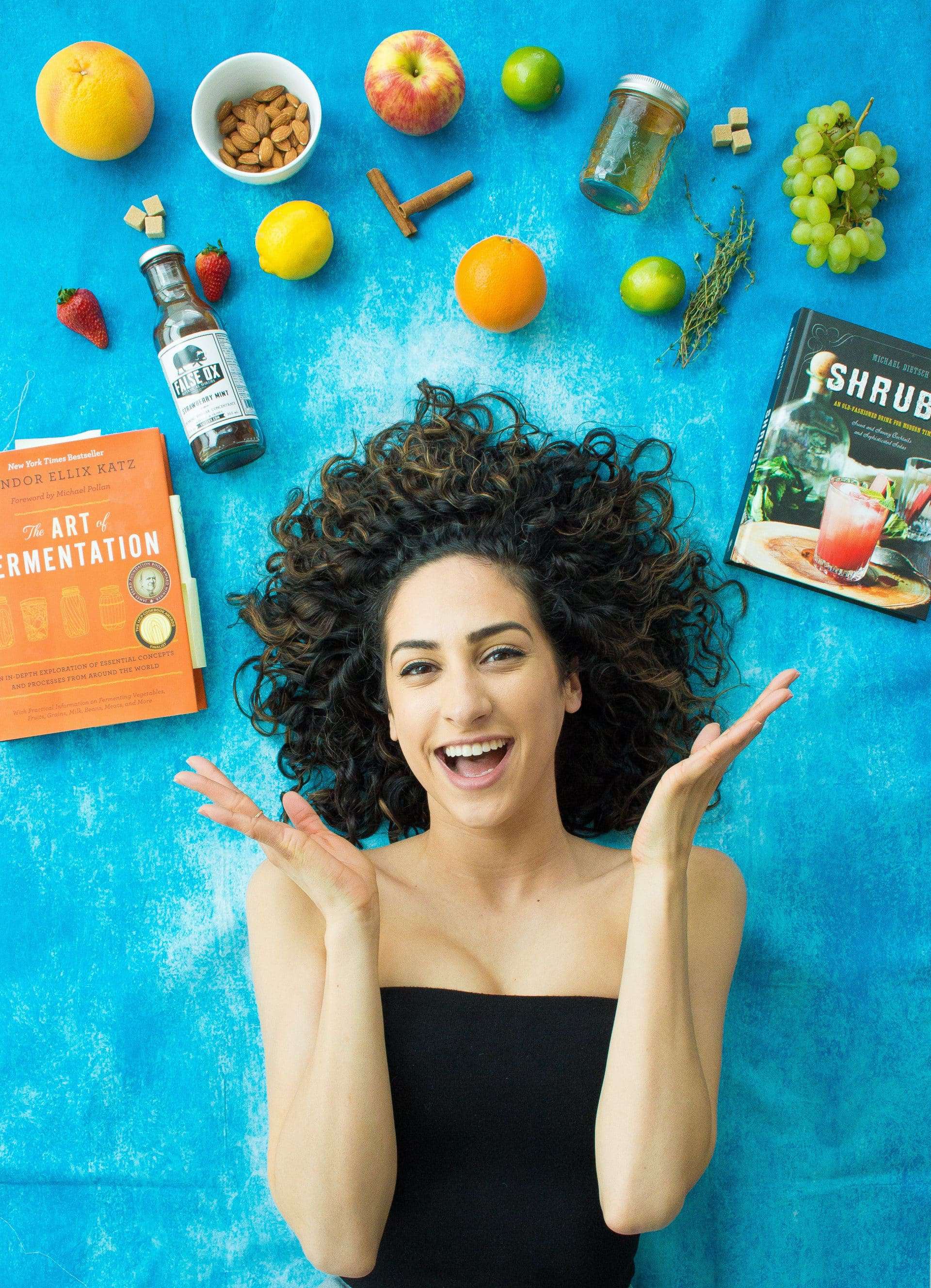You’re probably asking yourself the exact same question that I had when I first heard the word ‘Shrub’; What the hell is it? My little world didn’t involve vinegar based infusions because I just simply didn’t understand it. I couldn’t conceptualize that vinegar on it’s own could be good, because my instinct is to look like the sour patch kid when I think about drinking a full glass of vinegar.
Usually we’re intimidated by what we don’t know, but when you open your mind and your mouth to new possibilities, you’ll be SHOCKED at what you love. I’ll be going into depth about the world of Shrubs that you had never heard of, and if you have, well you might learn a thing or two. I’ll be going into detail about what is exactly a Shrub, the history behind the beverage, how it’s used, and much, much more!
What is it
In the simplest of terms, Shrubs is a vinegar-based beverage, infused typically with citrus and sugar. Because of this, the possibilities are virtually limitless with what you can create. Vinegar creates an environment that makes it extremely hostile for bacteria to grow, which makes it the ideal bed for fruit and sugar.
Once the Shrub is created, many can drink it on its own, top it with a seltzer, use as a marinade, or combine in a cocktail! Of course you are not limited to just fruits. Some other common ingredients paired with shrubs are herbs, vegetables and nuts. It’s a great way to preserve fruits well after its season, and explains why it was such a popular beverage during the colonial days.
History
Shrubs played an active and important role in history. The word itself comes from the Arabic word Sharab, which translates ‘to drink’. Its origins date back to Turkey and Persia, where they were traditionally referred to as Sherbets. Sherbets take on a completely different meaning today, but back then, it was referenced to as a sour-tonic beverage containing vinegar with fruits, sugar, herbs, nuts, and/or florals.
Dating back to the colonial era, this was one of the most popular ways to preserve fruit. It was a way to sterilize dirty water, and utilize fruits and vegetables that would normally go to waste. Since vinegar contains a healthy amount of Vitamin C, it was also one of the preventative measures against Scurvy.
Looking back to where shrubs originate, it was favourable amongst muslims abstaining from alcohol. Utilizing spices, herbs and fruit, this was a way for muslims to enjoy a tasty and refreshing beverage, while keeping to their cultural guidelines. In addition, water contamination was a common issue, resulting in limited resources for daily fluid intake. Shrubs proved to be a beverage that quenched thirst and was safe enough to drink! Popularity for Shrubs increased again during the temperance and prohibition era. Again, you have a generation practicing abstinence, who was looking for a viable, tasty and non-alcoholic beverage to enjoy.
Although Shrubs was commonly imbibed on its own, and used as a practice for abstinence, shrubs became a common ingredient in cocktails as well. The most traditionally paired liquor was either Rum or Brandy. Since Shrubs were popular amongst the navies and sailors to fight against Scurvy, it makes sense that the sailors themselves would experiment and become mixologists. In the end, alternative methods to prevent scurvy were discovered and shrubs lost their of popularity.
How it’s Made
Shrubs are traditionally created in two methods; a Hot or Cold Process. The Hot Process Method involves cooking the fruit with sugar and water to form a syrup, then later strained and combined with vinegar. In the Cold Process Method, the fruit and sugar is left to macerate for 1-2 days, and then strained and combined with vinegar. Both processes have their strengths and weaknesses. The Hot Process is much quicker to produce and only adds an additional 5-10 minutes to your prep time, but by cooking certain fruits and vegetables, you lose the vibrancy and brightness from the fruit. From all my research and my own experimenting, the Cold Process is the tastier option.
In the Cold Process, combining the sugar and fruit allows the juices to fully extract, while keeping the brightness of the fruit. Because of this, it is best to stick with granulated or brown sugar. Agave, honeys and syrups take a bit more time to break down, and as much as I have patience to create shrubs at home, I’m not that patient! With granulated sugar, you are also having little influence on the flavours of the fruit, where I find agaves and syrups are much more distinctive. Again, this is completely up to you and what you think would best pair with your combination.
Choosing Vinegars and Fruits
Now it’s time to understand the options when it comes to choosing a vinegar. There’s an abundances of choices to be made, but the most versatile to Shrub making and the easiest to work with is Apple Cider Vinegar. It’s one of the easiest vinegars to pair due to its flavour compatibility, accessibility within supermarkets, and its relatively inexpensive.
Although Apple Cider is one of the most commonly used vinegars for Shrub-making, you do have options! When it comes to White Wine Vinegars, these tend to work best with stone fruits to match its brightness and acidity levels. Balsamic is avoided since it’s quite overwhelming on its own, and red wine vinegar is best paired with berries! Again, these are guidelines that don’t necessarily have to be followed. For example, the Peach, Raisin and Cinnamon Shrub recipe I created used Apple Cider Vinegar. As much as stone fruits pairs well with white wine vinegar, I had infused raisin and cinnamon to the peach shrub. Naturally, this combination pairs perfectly with apples, so I knew that Apple Cider Vinegar would be a strong choice here.
As an important side note, you don’t have to pick out the nicest looking fruits in the basket. In this case, bruised, damaged and/or very ripe fruits are definitely the way to go when choosing produce for your shrub. It’s best to use fruits when they are in season, so come summer time, make sure to give this a try!
How to Stored
Other than making sure the jars and containers are well sterilized and cleaned, you don’t have to stress too much about spoilage with Shrubs. I prefer to leave it in the fridge, but if you have limited space, keep the shrubs in a dark, cool area (just as you would with infusions). If kept in a fridge, shrubs can last for a minimum of 6 months. As I mentioned earlier, vinegar creates an environment that makes it very difficult for bacteria to grow, so you’re pretty much safe when it comes to shrub making! You will want to look for obvious signs of spoilage and mold, but trust your judgement! If something seems off, just toss it.
Beneficial Aspects
Vinegar seems to be that all-in-one product WONDER. It’s thrown into the laundry, used for cleaning, helps with digestion and so much more. All in all, where would our lives be without vinegar? Would we have discovered the wonders of wine? Okay, back to the point. I did a bit of research in the benefits of vinegar, and it confirmed what I figured to be true about its health benefits! Amongst some of the research found, vinegar aids in lowering cholesterol, reducing body weight and improves overall heart health. It also helps those with diabetes by lowering their blood sugar levels. Don’t believe me? Take a look at some of the scientific research that I reference below on the benefits of vinegars!
Shrub Making Ratio
As a rule of thumb, I create shrubs with this ratio in mind
4 – 1 – 1
The 4 represents 4 parts fruit and spices, 1 part Sugar, and 1 part Vinegar.
Now before you start thinking this is the one and only way that works, I want to remind you that this is should be used as a guideline, and not necessarily the case for all produce. For example, I find Raspberries and Strawberries quite ‘loud’ berries. What I am saying is that they have strong flavours to begin with, so you may not need to add the same amount of fruit for it to be pronounced within the Shrub. In the other side of the spectrum, pears and grapes tend to have softer, quiet notes, so I would increase the fruit to approximately 5 or 6 parts against the sugar and vinegar.
Conclusion
To summarize, shrubs are a good thing. It lost a bit of its facade in the recent decades, but I’m looking to bring a bit of spotlight back into this traditional and tasty beverage. Now if you’ve done the work, and read this entire article, I’m sure you’re pretty much ready to give shrub making a go! Keep your eyes open for new and exciting shrub pairings that I come up with on Liquid Culture. Until next time! Cheers!
References
I couldn’t provide you with all this information if it weren’t for the help of some very handy books and articles. I have them listed below here:
Ellen Zachos. The Wildcrafted Cocktail. 2017.
Michael Dietsch. Shrubs: An Old-Fashioned Drink for Modern Times. 2016.
Sandor Ellix Katz. The Art of Fermentation. 2012.
https://www.healthline.com/nutrition/6-proven-health-benefits-of-apple-cider-vinegar
A Samad, A Azlan, A ismail. Therapeutic effects of vinegar: a review. Current opinion in Food Science. 2016. https://www.sciencedirect.com/science/article/pii/S2214799316300479

